In-House vs Outsourcing: Choosing the Right Mobile App Development Team Model
Ditstek Blogs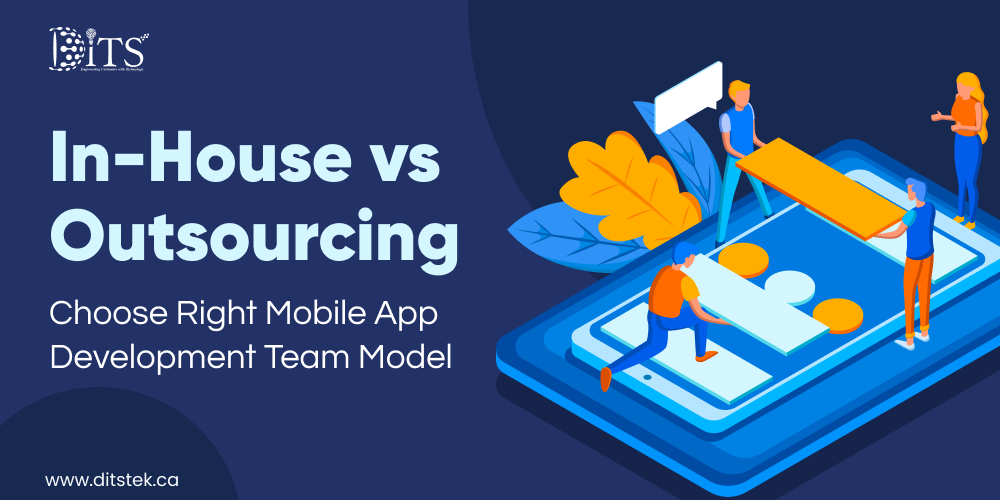
As most people search for products and services on their smartphones, choosing to build mobile apps for users is crucial for any business. However, mobile apps work best only when developed by an expert development team. Businesses have two options to build their mobile apps in-house development team and outsourcing.
Businesses can choose any model depending on their requirements. However, some find it challenging to choose between in-house development and outsourcing.
Going In-house allows businesses to be in charge and get the team to know their goals and fit their work culture, but need to train the team about new technology. On the other hand, outsourcing the app development to a software development company that already has the knowledge, expertise and experience.
According to Statista, global app development outsourcing is projected to reach US$806.55 billion by 2030 which simply means that most companies are choosing an outsourcing model due to the multiple benefits it offers for app development.
With more and more businesses looking to outsource app development, outsourcing is definitely a hot trend. This blog shares which model should organizations choose between an in-house and outsourcing mobile app development team, and what things they need to consider while choosing a model.
Build Innovative and Scalable Apps, Faster Time to Market!
DITS app development team builds innovative, scalable apps that help you launch soon and align with your business goals.
Why Choosing Right Development Model Is a Strategic Decision
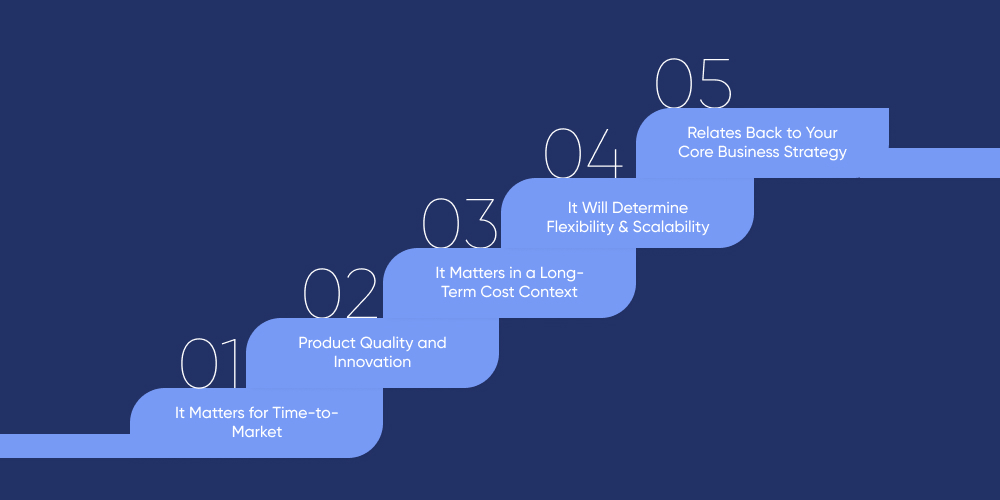
Making a choice between in-house mobile app development and outsourcing mobile app development is a strategic business decision which will influence the success of a digital product. Here are the reasons why it is important to choose the right model for any mobile app development project :
1. It Matters for Time-to-Market
The model a business employs will determine how soon it can turn an idea into a product for its users. If the market opportunity is time-sensitive, being able to scale quickly with an outsourced team gives a competitive advantage. In contrast, in-house hiring is time taking, which will slow down the development and time-to-market for a product.
2. Product Quality and Innovation
For example, an in-house team within a company culture will likely have a better understanding of its brand and long term vision. On the flip side, an adroit outsourced partner may come up with innovative ideas, provide the most current technical knowledge, and demonstrate cross-industry experiences which internal teams usually lack.
3. It Matters in a Long-Term Cost Context
The savings gained by using an outsourced model may appear appealing at first, however, sometimes the long term investment of building a skilled internal team yields much better return through better control and ownership of products over time and ultimately costs less in the end. The chosen model is important and can lead to hidden costs, delays or failure.
4. It Will Determine Flexibility & Scalability
Will an organization be able to scale the development resources when its team is on peak, or pivot with a partway through? The model it selects will determine how mobile or adaptable that company is. Outsourcing will give it more flexibility, in-house will give it more continuity, but it is harder to scale.
5. Relates Back to Your Core Business Strategy
A mobile app isn't just another product, it is often a way to acquire customers, serve customers, or provide another avenue for revenue. The way that the app is built, maintained, and modified over time is very much related to a company's overall business objectives, acceptable levels of risk, and technical maturity.
Key Comparison Factors to Choose a Mobile App Development Team
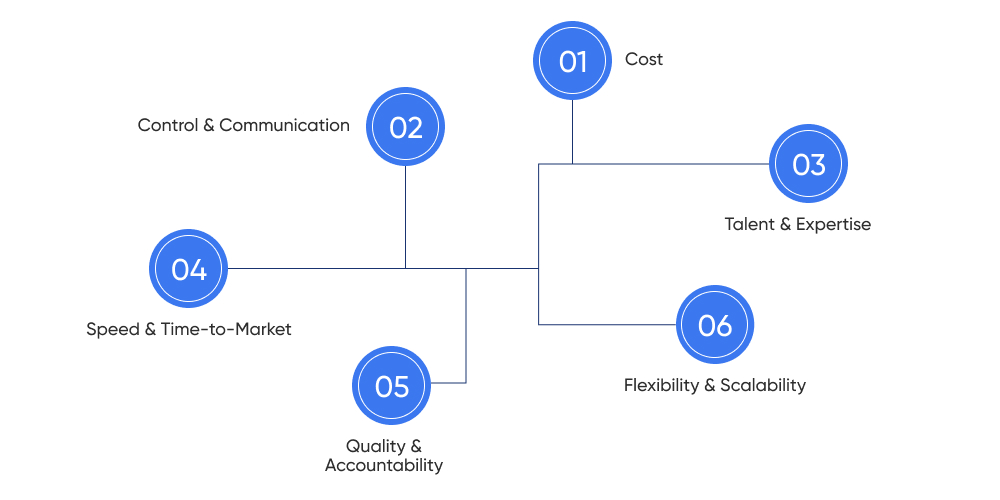
While choosing between in-house and outsourcing, it’s crucial for organizations to compare both models across key business and technical dimensions. Here is a table showing the key comparison factors between in-house and outsourced development models.
| Comparison Factor | In-house Development | Outsourced Development |
| Cost | Higher long-term costs (salaries, benefits, infrastructure) | Lower and predictable costs, especially for short-term projects |
| Control | Full control over team, process, and decision-making | Limited control; dependent on vendor's processes |
| Communication | Easier communication with on-site or nearby teams | May face challenges due to time zone and cultural differences |
| Talent Availability | May face local hiring challenges and skill gaps | Access to global talent and niche expertise |
| Quality Assurance | Tailored quality control based on internal standards | Relies on vendor’s QA practices and SLAs |
| Scalability | Scaling requires hiring, training, and infrastructure expansion | Easier and faster to scale up or down based on needs |
| Speed to Market | Slower setup and ramp-up time | Faster time to market with ready talent and processes |
| IP Security & Confidentiality | High control over intellectual property and data security | Potential risks; requires strong contracts and due diligence |
| Cultural Fit | Strong alignment with company values and mission | May vary depending on outsourcing partner |
| Long-term Suitability | Better for long-term, evolving products | Ideal for MVPs, prototyping, or projects with fixed scope |
Here's a detailed breakdown of the key comparison factors:
Cost
In-house development comes with an up-front and ongoing investment: resource procurement (salaries, benefits, recruiting, office space, equipment, training, etc.). Even in slow periods, fixed costs still exist. Outsourcing, on the other hand, provides a more flexible approach to pricing (by the hour, or for the entire project).
This often affords better budget control, especially for start-ups or organizations with limited internal technical capabilities. But both models have the possibilities of hidden costs: in-house costs via attrition and delays in hiring; and outsourcing costs due to potential re-work through miscommunication or poorly defined project scope. Businesses need to do a thorough cost-benefit analysis before choosing any model.
Control & Communication
With in-house development, companies have total control over the project, workflows and priorities. They communicate directly, making it easier to oversee day-to-day initiatives, provide constructive feedback and improve quickly. An in-house team has a common culture, values and business ethics.
While outsourcing, communication is generally dictated on being more structured (usually through a project manager) and it uses collaborative tools, i.e. Slack, Zoom, Jira etc. There's the risk of communication lag due to differences in time zones, or language challenges, but this can be reduced with predefined processes, regular check-ins and notes, and documentation on the project requirements.
Talent & Expertise
In-house teams have a much deeper understanding of your brand, customer requirements, as well as product goals over the course of time. However, hiring and staffing technical talent can take time and expense, especially at the cutting edge of technology like AI and IoT.
Outsourcing offers access to a worldwide pool of talent and, potentially, niche expertise. Companies have the option to hire or source experienced developers, for a specific time frame, without long term commitments.
Furthermore, outsourcing affords you the flexibility to staff a variety of experts working alongside, and you will not need to limit the experience of the service providers to one specific stack of technology.
Speed & Time-to-Market
Speed is a critical factor in mobile app development. Although in-house is optimal for a majority of businesses, it is often restrained as a result of onboarding, hiring, and infrastructure setup. It may take months to ensure the right teams are in place; before development is even started.
Outsourcing allows you to completely avoid the setup that comes with in-house development. In fact, most offerings available to you already have teams pre-staffed and vetted. Hence, the time to market decreases significantly or becomes immediate (i.e., for MVP or in the case of a competitive launch).
In mobile app development, where speed and agility are the key business KPIs, outsourcing for tech development typically outweighs in-house development as the faster solution with the option for scalability.
Quality & Accountability
With in-house teams, you have greater control over development quality, testing methods and long-term maintainability of deliverables. However, having quality assurance requires effective internal processes and levels of leadership. The quality of outsourced work depends on the service provider’s expertise and experience in mobile app development.
For that reason, it is very important to consider and analyze the outsourcing provider's portfolio, past client testimonials, certifications, and their SLAs (Service Level Agreements). In general, reputable companies like DITS in Canada adhere to industry standards, use dedicated QA, and use agile methodologies. Accountability in outsourcing is also improved by contracts that define deliverables, timelines, quality, and performance metrics.
Flexibility & Scalability
In-house teams provide the best solution in situations where organizations need long-term production capacity. Scaling up or down will take significant time and resources. Even adding new employees involves recruiting, onboarding and training only to be done again if you need to reduce staff.
Outsourcing provides internal flexibility that is not possible with in-house teams. If the need arises, there is nothing easier than to hire more resources or to shed resources as needed. As such, outsourcing is a great solution for startups, and companies working with an uncertain roadmap, or managing multiple concurrent projects.
Many of us have looked into outsourcing our product development somewhere that offers advantages like cheaper salaries or a larger talent pool. However, there are many benefits of employing an in-house development team, such as the following:
Grow Faster with Smarter Mobile App Solutions!
DITS helps businesses reduce time-to-market, improve user engagement, and scale faster with agile mobile app development strategies.
Pros of in-house development
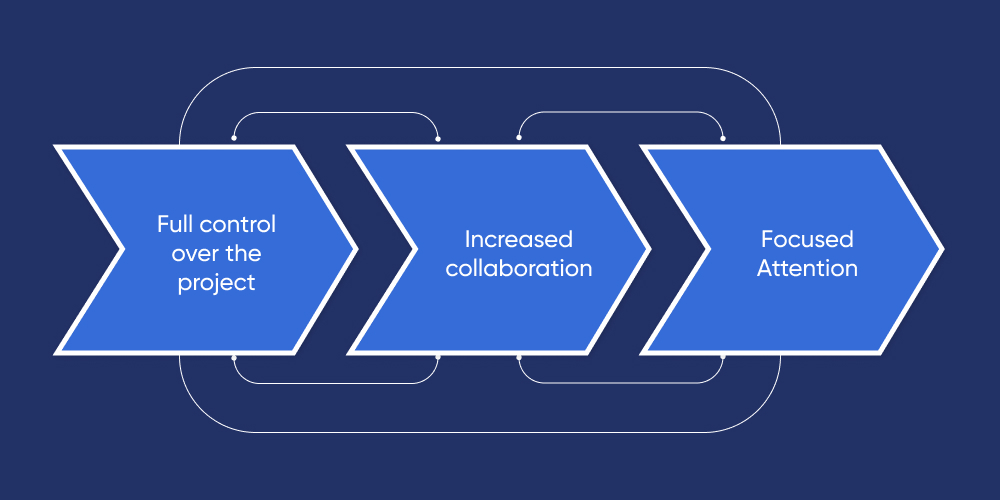
Full control over the project: You have full control over timelines, priorities and workflows when the development team is in-house. You won’t have to depend on outside teams or adhere to other third-party schedules.
Increased collaboration: Working at the same physical site results in less lag time, more effective communication, quicker feedback loops, and alignment with the values and culture of the business.
Focused Attention: In-house developers usually only work on your product or projects. This typically results in increased product ownership and innovation over time.
Cons of in-house development
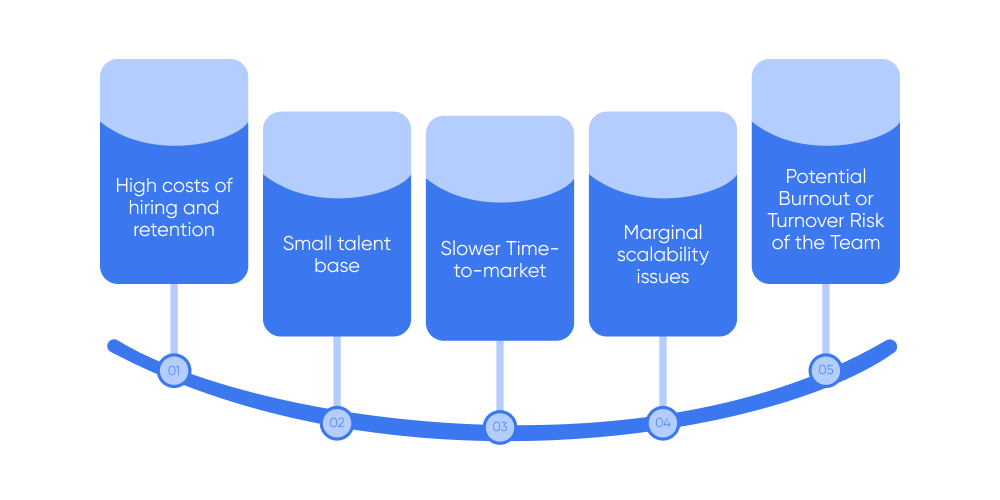
High costs of hiring and retention: A combination of salaries, benefits, onboarding, training, and office space can increase your expenses of development wildly. Building an in-house team and keeping it sustained can be costly and a much higher cost in a competitive market.
Small talent base: When you are geographically constrained, hiring talent to sustain in-house development can be limiting. It can take time to find the developers with the exact technological experience that your app and company need (for example: - React Native, AI... etc.)
Slower Time-to-market: It takes time to recruit and onboard a team. If you are on a short time-to-market or launch schedule, this can delay your project significantly.
Marginal scalability issues: Usually, if your project is going great, you will need to hire on more people and add more infrastructure capacity - not very attractive if your projects have waves of workload and unpredictable timelines.
Potential Burnout or Turnover Risk of the Team: Long-term projects can lead to mild burnout and your team's enthusiasm or velocity will decrease.
Pros of Outsourced Software Development
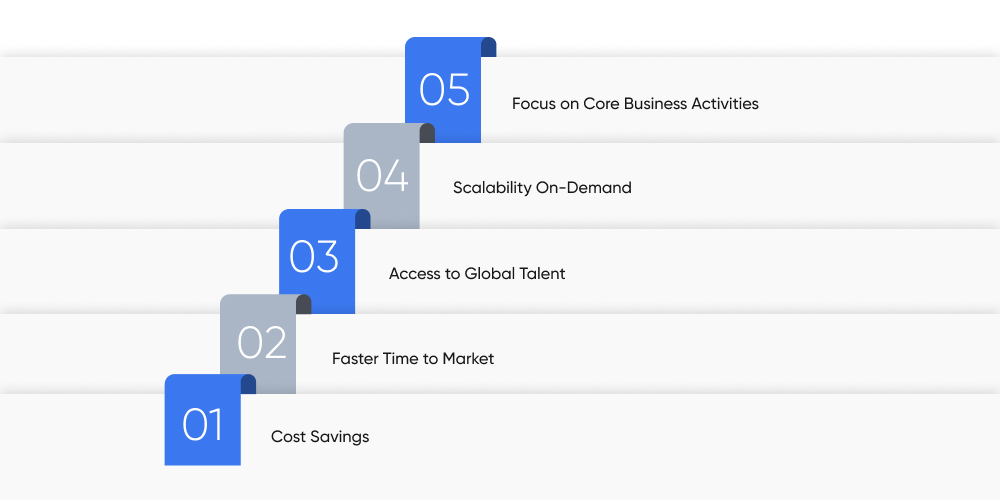
Cost Savings: Outsourcing allows you to eliminate the overhead costs of full-time salaries, benefits, infrastructure, and HR costs. You only pay for the work that gets done, great for startups or those needing to watch their budgets closely.
Faster Time to Market: Once an efficient external team is in place, development starts sooner and timelines are generally shorter, particularly if you are aiming for a quick MVP launch.
Access to Global Talent: Outsourcing increases your options for specialized skills you may not have locally and can find in another region in the world, anywhere from Flutter, to AI, or various types of experiences tied to the industry.
Scalability On-Demand: Need to scale fast? The ability of outsourced vendors to ramp up and scale down easily as needed based on the project, is value-added without the penalties of hiring and laying off.
Focus on Core Business Activities: With an internal resource working on app development, you can spend your time as a company on what really helps the business grow; defending your product vision, marketing and customer engagement.
Cons of Outsourced Development
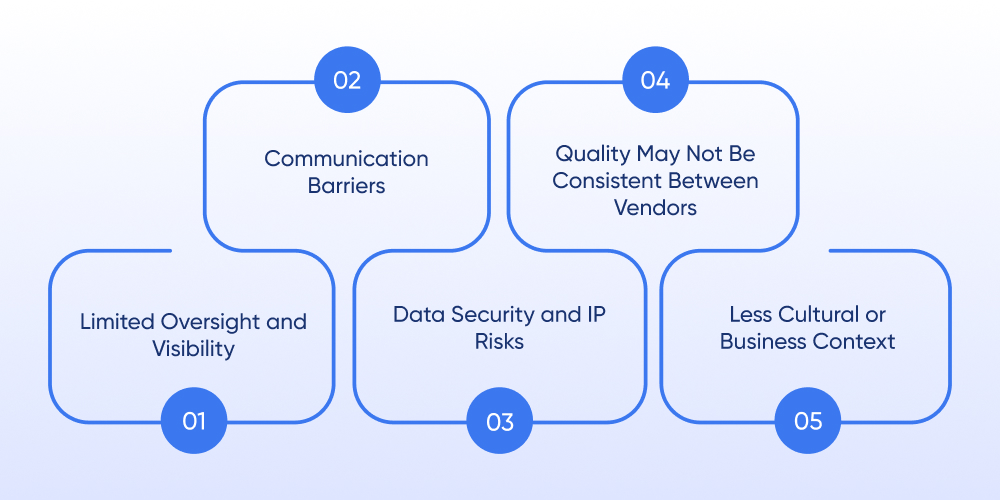
Limited Oversight and Visibility: You are relying on a third party for your product. If you do not have adequate supervision, you run the risk of delays, conflicting priorities, or unmet expectations.
Communication Barriers: Time zone issues, a language barrier, or different communication practices could harm collaboration or progress if it is not monitored.
Data Security and IP Risks: There are risks involved with sharing sensitive business data with outside parties, including data security and intellectual property concerns, making legal agreements and vendor due diligence necessary.
Quality May Not Be Consistent Between Vendors: Outsourcing companies vary. If a company is not held accountable, some may cut corners or produce inferior products.
Less Cultural or Business Context: An external team may not retain an accurate understanding of your company’s mission, product vision, and user expectations, which may impact the end user.
Is Your Mobile App Development Team Costing You More?
Discover whether an internal team or outsourcing delivers better ROI for your mobile project. We’ll help you evaluate.
When to Build In-House Development Team
There are some scenarios where in-house development offers better results.
You Need Full Control Over Every Phase
If a project demands oversight, rapid communication and collaboration, and strict alignment with your business goals, then an in-house team offers total control. The in-house team manages every step of the process; from planning to development to testing, all under one roof.
You Have an Existing Development Culture or Tech Team
Extending an in-house team makes the most sense if your company already has a technical team or a strong software engineering culture. Existing alignment in tools, processes, and architecture can speed development and onboarding.
When Should You Outsource Software Development Company
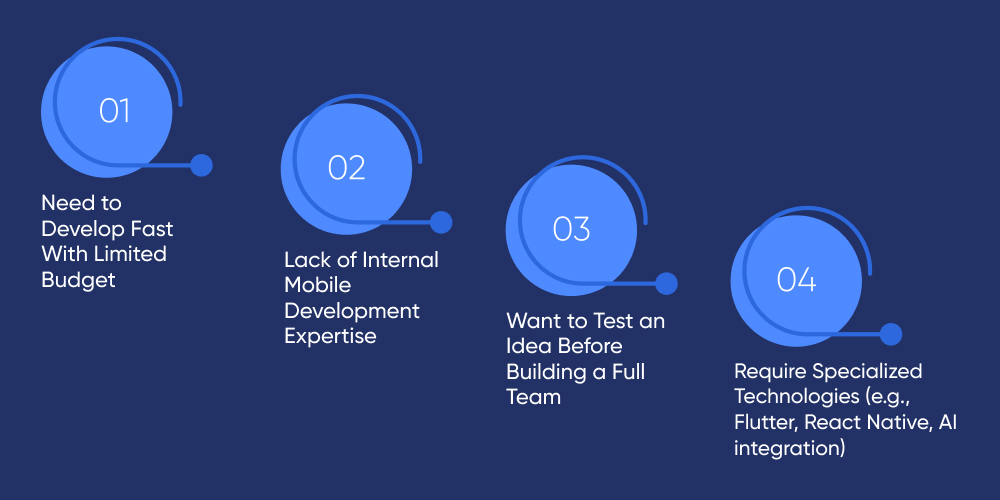
There are some scenarios where outsourcing is beneficial as compared to in-house development.
Need to Develop Fast With Limited Budget
Ideally, outsourcing is for organizations that need to build and launch that app quickly without having to devote a large budget to the upfront costs. Hiring and establishing an in-house team requires both time and money, while a software development outsourcing firm has existing developers, designers and testers ready to work.
Lack of Internal Mobile Development Expertise
If an organization does not have internal mobile app development capability, or only has capabilities in other areas such as web development, outsourcing provides that immediately. Outsourcing companies like DITS in Canada offers access to expertise on mobile specific platforms, frameworks, UI/UX, and performance optimization
Want to Test an Idea Before Building a Full Team
When you are launching a new product or feature and want to validate the opportunity before making a long-term investment in a team, then outsourcing is a great option. It allows you to quickly and cost-effectively build a prototype or a minimum viable product.
Require Specialized Technologies (e.g., Flutter, React Native, AI integration)
When your project has a requirement for advanced technologies (e.g., cross-platform frameworks - Flutter/ React Native, AI, or IoT development), outsourcing provides a quick way to get specialized capabilities.
Why Choose DITS Mobile App Development Team?
DITS is a custom software development company in Canada that offers software and mobile app development services globally. Mobile app development specialized skills in Java, Swift (iOS) and familiarity with React, Native and Flutter. Also, the developers should have experience working on these programming languages and frameworks.
The mobile app development team at DITS has specialized knowledge and expertise in Java, Swift, React, Native, Flutter and other technologies used for building mobile apps. We have developed mobile apps for healthcare, transportation, logistics, business automation and IoT. Our developers have knowledge of AI and IoT technologies that enables them to build mobile apps and deliver faster.
We also offer ongoing support and maintenance services to ensure the mobile apps works as intended and get updates from time to time. Businesses looking to build mobile apps can visit our website and fill the contact us form and our team will get back to them shortly.
What Makes the DITS Mobile App Development Team Stand Out?
From concept to code, our team blends strategy with precision to deliver high-impact mobile solutions.
Conclusion
Deciding between in-house and outsourced mobile app development relies on your project objectives, budget, timelines, and long-term perspective. In-house teams provide higher levels of control and better alignment with your company culture around the project objectives and vision, while outsourced teams can allow you to tap into a global pool of talent, lower costs, and scalability.
Outsourcing gives you the option to quickly scale the project, put specific expertise at your disposal, and shorten the time-to-market. Also, outsourcing has a strong tendency to allow businesses (especially to startups and SMEs) to take a more flexible, cost-effective, and results-driven approach without losing the elements of creativity and innovation that are important to businesses that develop mobile apps.
FAQs
What is the main difference between an in-house and outsourced mobile app development team?
An in-house mobile app development team is located inside your organization, while an outsourced team is hired from outside your organization. Essentially, the biggest difference is the location of the team, the level of control, cost, and flexibility.
Why should I consider outsourcing my mobile app development team?
Outsourcing mobile app development gives you the opportunity to access global talent, faster delivery times, and it can even improve your app development costs, without going through the hiring process or building the infrastructure.
Can an outsourced mobile app development team deliver the same quality as in-house?
Yes. An outsourced mobile app development team that really has their stuff together will bring the same level of quality to the table that an in-house solution would offer and they will likely have had years of in-market experience and refined processes, which can count for a lot.
What types of mobile app development services does DITS offer?
DITS provides a full range of mobile app development services, including UI/UX design, native and cross-platform app development, backend integration, testing on iOS and Android, and post-launch support. We build custom apps based on your business needs.
Does DITS provide cross-platform mobile app development?
Yes! DITS provides cross-platform mobile app development using frameworks such as Flutter and React Native that help to provide a consistent user experience across both iOS and Android.
Can DITS scale the mobile app development team as our project grows?
Yes, DITS provides flexible engagement models, so you have the ability to scale your mobile app development team up or down when you see fit as project requirements evolve.

Dinesh Thakur
21+ years of IT software development experience in different domains like Business Automation, Healthcare, Retail, Workflow automation, Transportation and logistics, Compliance, Risk Mitigation, POS, etc. Hands-on experience in dealing with overseas clients and providing them with an apt solution to their business needs.
Recent Posts
Get in touch











 Calgary | Edmonton | Vancouver | Toronto
Calgary | Edmonton | Vancouver | Toronto